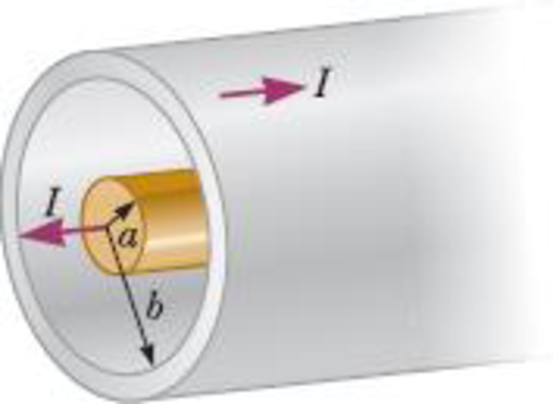
Concept explainers
Review. The use of superconductors has been proposed for power transmission lines. A single coaxial cable (Fig. P23.73) could carry a power of 1.00 × 103 MW (the output of a large power plant) at 200 kV, DC, over a distance of 1.00 × 103 km without loss. An inner wire of radius a = 2.00 cm, made from the superconductor Nb3Sn, carries the current I in one direction. A surrounding superconducting cylinder of radius b = 5.00 cm would carry the return current I. In such a system, what is the magnetic field (a) at the surface of the inner conductor and (b) at the inner surface of the outer conductor? (c) How much energy would be stored in the magnetic field in the space between the conductors in a 1.00 × 103 km superconducting line? (d) What is the pressure exerted on the outer conductor due to the current in the inner conductor?
Figure. P23.73

(a)
The magnetic field at the inner surface of the conductor
Answer to Problem 73P
The magnetic field at the inner surface of the conductor has a value of
Explanation of Solution
Write the equation for the ampere’s law.
Here,
Write the equation for the power on a single cable.
Here,
Conclusion:
Substitute
Therefore, the magnetic field at the inner surface of the conductor has a value of
(b)
The magnetic field at the inner surface of the outer conductor
Answer to Problem 73P
The magnetic field at the inner surface of the outer conductor has a value of
Explanation of Solution
Write the equation for the ampere’s law from equation (I).
Here,
Write the equation for the power on a single cable. From equation (II).
Here,
Conclusion:
Substitute
Therefore, the magnetic field at the inner surface of the outer conductor has a value of
(c)
The energy stored in the magnetic field
Answer to Problem 73P
The energy stored in the magnetic field in the space between the conductors is
Explanation of Solution
Write the equation for the energy density in the magnetic field.
Here,
Write the equation for the energy stored in the magnetic field.
Here,
Write the equation for the change in volume of the conductor.
Here,
Substitute equation (I) and equation (III) in equation (II).
Substitute equation (I) in equation (VII).
Conclusion:
Substitute
Therefore, the energy stored in the magnetic field in the space between the conductors is
(d)
The pressure exerted on the outer conductor
Answer to Problem 73P
The pressure exerted on the outer conductor is
Explanation of Solution
Consider a small rectangular segment with length
Write the equation for the outward force experienced by the rectangular segment.
Here,
Substitute
Write the equation for the pressure exerted on the outer conductor.
Here,
Conclusion:
Substitute equation (X) in equation (XI).
Therefore, the pressure exerted on the outer conductor is
Want to see more full solutions like this?
Chapter 23 Solutions
Principles of Physics: A Calculus-Based Text
- please help me solve this questions. show all calculations and a good graph too :)arrow_forwardWhat is the force (in N) on the 2.0 μC charge placed at the center of the square shown below? (Express your answer in vector form.) 5.0 με 4.0 με 2.0 με + 1.0 m 1.0 m -40 με 2.0 μCarrow_forwardWhat is the force (in N) on the 5.4 µC charge shown below? (Express your answer in vector form.) −3.1 µC5.4 µC9.2 µC6.4 µCarrow_forward
- An ideal gas in a sealed container starts out at a pressure of 8900 N/m2 and a volume of 5.7 m3. If the gas expands to a volume of 6.3 m3 while the pressure is held constant (still at 8900 N/m2), how much work is done by the gas? Give your answer as the number of Joules.arrow_forwardThe outside temperature is 25 °C. A heat engine operates in the environment (Tc = 25 °C) at 50% efficiency. How hot does it need to get the high temperature up to in Celsius?arrow_forwardGas is compressed in a cylinder creating 31 Joules of work on the gas during the isothermal process. How much heat flows from the gas into the cylinder in Joules?arrow_forward
- The heat engine gives 1100 Joules of energy of high temperature from the burning gasoline by exhausting 750 Joules to low-temperature . What is the efficiency of this heat engine in a percentage?arrow_forwardL₁ D₁ L₂ D2 Aluminum has a resistivity of p = 2.65 × 10 8 2. m. An aluminum wire is L = 2.00 m long and has a circular cross section that is not constant. The diameter of the wire is D₁ = 0.17 mm for a length of L₁ = 0.500 m and a diameter of D2 = 0.24 mm for the rest of the length. a) What is the resistance of this wire? R = Hint A potential difference of AV = 1.40 V is applied across the wire. b) What is the magnitude of the current density in the thin part of the wire? Hint J1 = c) What is the magnitude of the current density in the thick part of the wire? J₂ = d) What is the magnitude of the electric field in the thin part of the wire? E1 = Hint e) What is the magnitude of the electric field in the thick part of the wire? E2 =arrow_forwardplease helparrow_forward
 Principles of Physics: A Calculus-Based TextPhysicsISBN:9781133104261Author:Raymond A. Serway, John W. JewettPublisher:Cengage Learning
Principles of Physics: A Calculus-Based TextPhysicsISBN:9781133104261Author:Raymond A. Serway, John W. JewettPublisher:Cengage Learning Physics for Scientists and EngineersPhysicsISBN:9781337553278Author:Raymond A. Serway, John W. JewettPublisher:Cengage Learning
Physics for Scientists and EngineersPhysicsISBN:9781337553278Author:Raymond A. Serway, John W. JewettPublisher:Cengage Learning Physics for Scientists and Engineers with Modern ...PhysicsISBN:9781337553292Author:Raymond A. Serway, John W. JewettPublisher:Cengage Learning
Physics for Scientists and Engineers with Modern ...PhysicsISBN:9781337553292Author:Raymond A. Serway, John W. JewettPublisher:Cengage Learning Physics for Scientists and Engineers: Foundations...PhysicsISBN:9781133939146Author:Katz, Debora M.Publisher:Cengage Learning
Physics for Scientists and Engineers: Foundations...PhysicsISBN:9781133939146Author:Katz, Debora M.Publisher:Cengage Learning College PhysicsPhysicsISBN:9781938168000Author:Paul Peter Urone, Roger HinrichsPublisher:OpenStax College
College PhysicsPhysicsISBN:9781938168000Author:Paul Peter Urone, Roger HinrichsPublisher:OpenStax College





